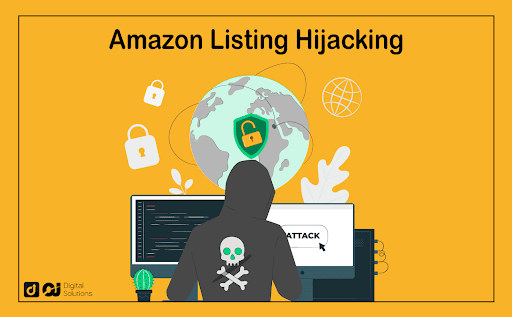Have you ever earned a bad rap as an Amazon seller due to another seller’s wrongdoing? Or are you seeing multiple sellers on a listing that you’ve created?
You’re not alone. This is called Amazon listing hijacking, and it’s a common (frutstrating) issue among private label sellers.
Unfortunately, some unethical sellers are here only to make a quick buck. An in order to do so, they might sell a counterfeit product on existing listing.
And the problem is that if one of those counterfeit items is part of your product listings, this counterfeit or similar version of your product will be sent to your customer.
And when that happens, if the product doesn’t match the item on the listing (logo & packaging), it will naturally cause unhappy customers, who might put a negative review on your listing, which might ruin your reputation and sales margin.
Don’t panic, I’m here to help.
I wrote this article to help you solve this issue, prevent it in the future, and win your customers back (while earning more) in case another seller tries to ruin your business by selling counterfeit items.
You will learn about:
The definition of Amazon listing hijacking
- How hijacking affects your business on Amazon
- The difference between Amazon hijackers and resellers
- Signs to look for to detect an Amazon hijacker
- Methods for dealing with this type of hijacking
- Ways to prevent hijackers from taking over your business
Whether you’re a buyer or seller, this article can empower you to keep Amazon a safe place to conduct business.
This issue is not as terrible as it sounds, once you get to know more about it. Let’s hit the ground running and start attacking this hijacking problem!
What Is Amazon Listing Hijacking?
An Amazon listing hijacked is a listing that can ruin your life in pretty much the same way as a hijacked airplane can rain on your flight plans.
The Amazon version of hijacking occurs when an unauthorized seller on the platform sells a counterfeit version of your product, on your same listing.
You can check if your listing is hijacked by opening it, and looking at the buy box (where you can purchase the product). If you’re the only seller, then it means that you’re safe.
However, if there’s some other seller, it means that an unsuspecting customer might purchase “your item” from someone else. Which doesn’t really make sense, as it’s not the exact same product advertised on the platform, even if it comes from the same factory, especially if you’ve added photos that include your logo and packaging, which will be impossible to replicate.
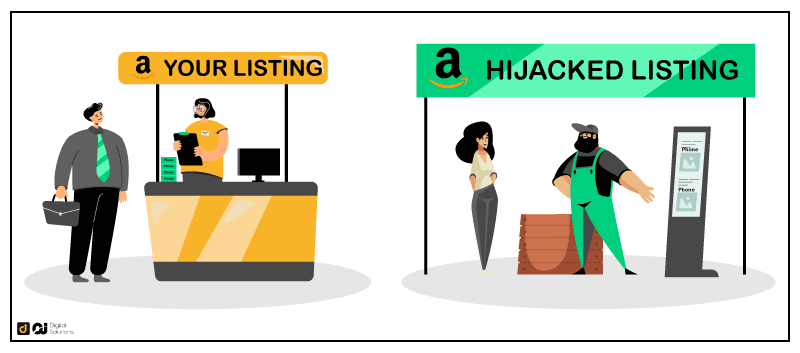
If multiple sellers do this unethical act involving your products, your troubles also multiply greatly.
Usually, those who carry out Amazon hijacking do their dirty deed by stealing your product photos and name, eventually listing their counterfeit items. And just like in brick-and-mortar stores, customers usually don’t see the difference between real and fake.
Mostly, you stand to lose customers who want to get more bang for their buck. After all, fake items are usually made of low-quality materials and can, therefore, be sold cheaper.
In the next section, you will discover that this issue will bring more problems aside from just lost income.
Impact of Hijacking on Your Amazon Business
Hijackers on Amazon turn your business dream into a nightmare through the following:
- Damaged reputation
- Tighter competition
- Lower metrics
- No Buy Box
Let’s take a look at each one by one and see what kind of havoc hijacking wreaks on sellers like you.
Ruined Reputation
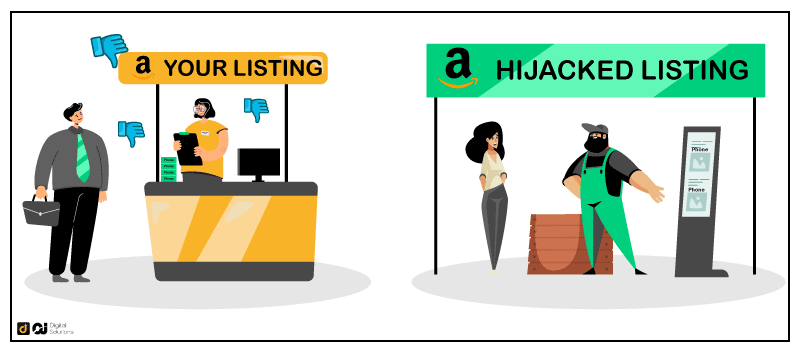
Getting the occasional bad review as an Amazon seller is part of daily business.
But if you’re mainly getting negative reviews, this can mean customers mistake you for the hijacker who’s selling them cheap but poorly-made products.
The more negative reviews you get, the fewer sales you could land because your reputation as a brand owner is ruined. And to think this is not your fault.
In case you don’t know where you stand regarding product reviews, you can read our helpful guide on how to view Amazon reviews.
More Competition Pressure
If customers see a cheaper version of your actual product through hijacker product listings, they would more likely flock to the less expensive alternative.
This adds to the number of competitor sellers you have to beat to earn the same amount of money.
After all, since hijackers sell items made of cheaper ingredients or raw materials, there’s little chance you can beat the prices they charge customers.
Less than Ideal Metrics
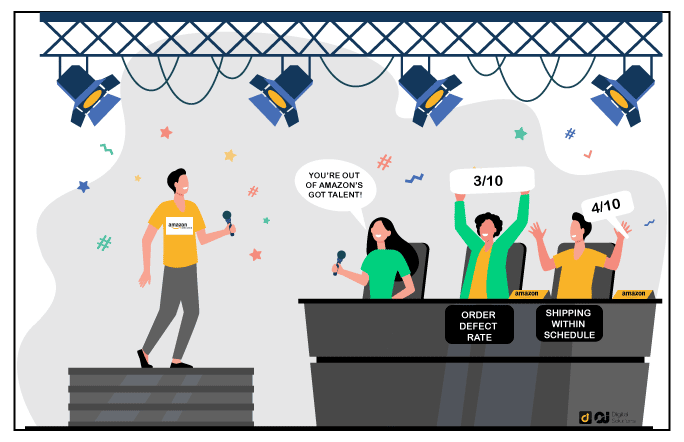
Selling on Amazon is a numbers game. If you don’t perform well according to the platform’s performance scorecard, you could:
- Get kicked out of Amazon as a seller
- Suffer lower sales figures due to lack of visibility among potential customers
Let’s have a closer look at each of the problems mentioned above.
Amazon Seller Account Closure
Amazon closes a seller’s account for many reasons. Among the reasons why your seller account could be closed include having a high order defect rate (a lot of your products are rated by customers as defective) and receiving condition complaints.
Since hijackers sell fake versions of your items, there is a greater chance these products would be defective or in bad condition.
When buyers send you messages complaining about the products they thought you sold (but were sold by hijackers), you would have a higher order defect rate or a lot of condition complaints, either of which could lead to account closure.
Less Profit Due to Less Visibility to Customers
Negative reviews not only ruin your reputation. They also hide your products from the eyes of many potential buyers.
How does this happen?
Amazon uses an automated programming system called the A10 algorithm to rank product listings on its search results pages (SERPs). The A10 algorithm takes into account customer reviews in deciding whether or not your listing goes near the top or the bottom of the Amazon SERPs.
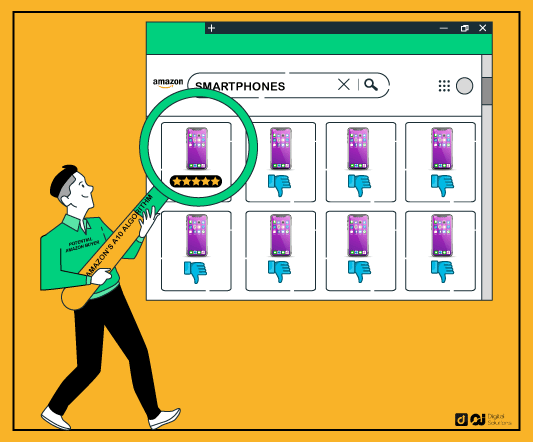
In other words, the more bad rap you receive, the less likely customers will see your product listings. The less they see your merchandise, the fewer sales you’ll get.
No Buy Box
The Buy Box is a badge of honor that Amazon awards to sellers who perform well in terms of criteria like reasonable pricing and good customer service.
The Buy Box enables Amazon customers to buy products more quickly since the Box provides Add to Cart and Buy Now buttons. These buttons enable buyers to make a purchase with the fewest clicks possible, making them more likely to buy products from listings with the said Buy Box.

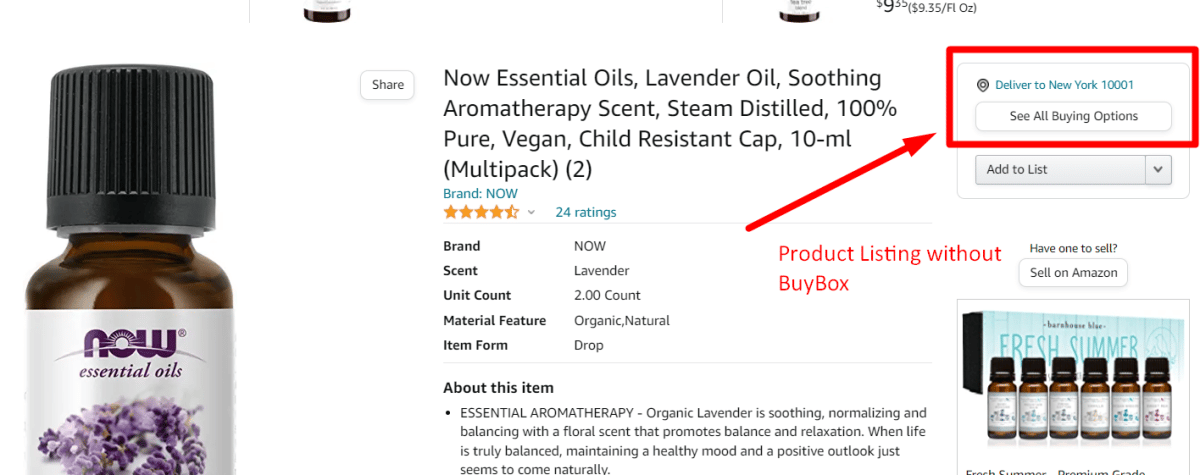
If hijackers are somehow able to sell a fake product with a similar level of quality to your merchandise, for a lower price, those hijackers can steal the Buy Box from you.
A Buy Box is a big deal especially since it increases the desirability of your products, giving you a higher profit margin.
How are Amazon hijackers different from Amazon resellers?
Resellers are legit. Hijackers are not.
The two are as different as day and night for the following reasons:
- Resellers sell real products, while hijackers sell fake ones.
- Resellers reveal that what they’re selling is used (if applicable), hijackers don’t.
- In general, Amazon resellers buy from a store (online or otherwise) other than Amazon. Hijackers create their own poorly-made products instead of buying those items.
Hijacker Red Flags

It’s tempting to go with guns blazing and deal with hijackers the rough and ready way.
But the most effective way to fight these counterfeiters is to be cold and methodical in your tactics, channeling your inner Sherlock Holmes in the process.
Here are some clues that help reveal an Amazon listing hijacker (take note these are just guides to start an investigation, a hijacker is innocent until proven guilty):
- There is a huge price difference between the product a hijacker is selling and the same product on your listing.
- You lost your Buy Box to another seller.
- Negative reviews and feedback have been flooding your seller account and/or customer service team.
- Other sellers are marketing the same private label product that can be found in your listings.
If you’re a private label product seller, watch out for product listings that sell the same products as you, but where the seller’s name is a person you did not authorize to sell or know about.
Remember that having your own brand name is not a total guarantee that hijackers won’t go after you.
If you’re a buyer on Amazon, if you see a similar offer for the same private label product but where the price is cheaper, the cheaper listing could belong to a hijacker. As a buyer, you’ll know a listing sells a private label item by checking out the encircled sections below (if the Brand and Sold By sections have the same name, the listing belongs to a private label seller).
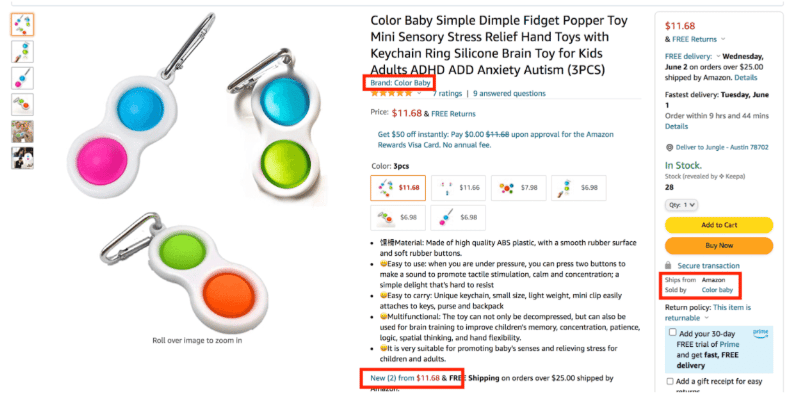
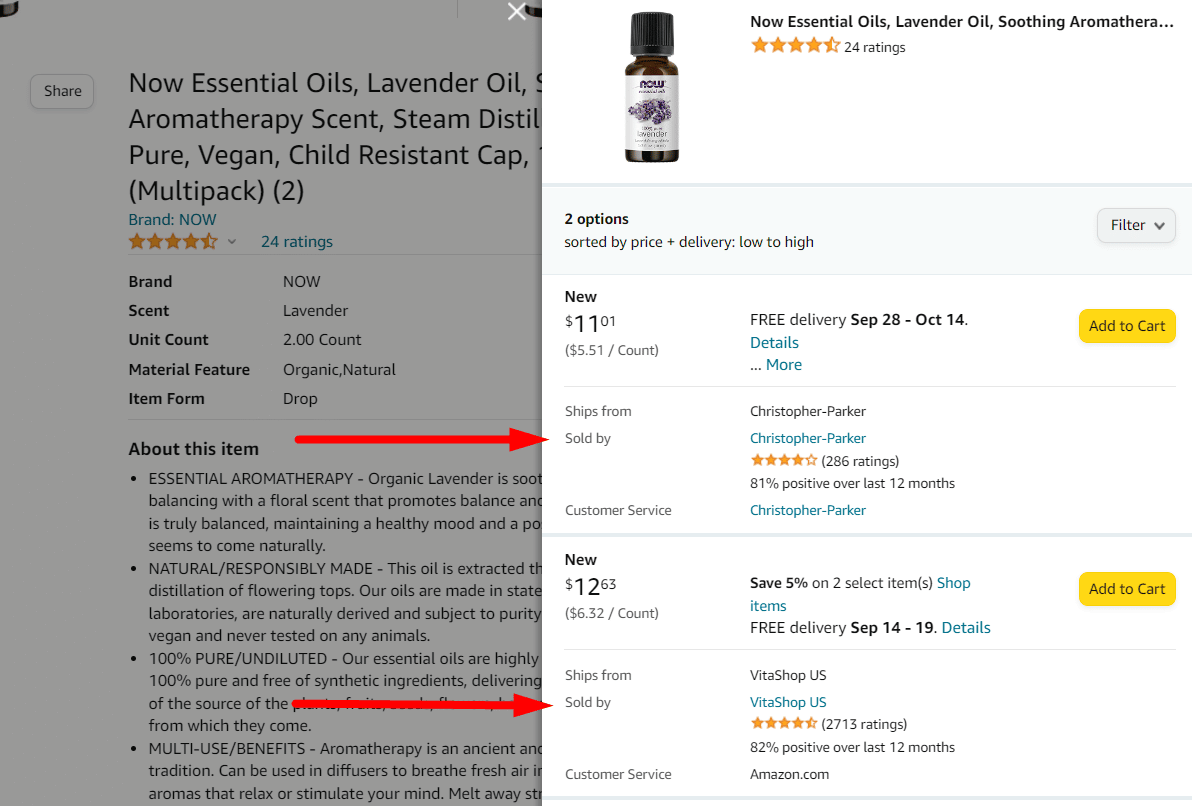
How to Deal with a Hijacker
Once you have established that another seller is a hijacker, there are many ways to deal with this person. Among which include:
- Writing a cease and desist letter to the hijacker
- Reporting the hijacker to Amazon
- Executing the buy and complain tactic
Take note, you should only carry out the second and third measures mentioned above if the hijacker does not cease after you send him an electronic letter. After all, though you may want to get rid of hijackers from the get-go, it is still best to give them the benefit of the doubt.
Let’s look at the nitty-gritty of each method in dealing with Amazon listing hijackers.
Sending a Hijacker a Cease and Desist Letter
This type of letter is your first course of action in dealing with fake product sellers. Through this letter, you inform a hijacker that you know he or she is up to no good.
In informing a hijacker, be as civil and courteous as possible (without sounding too soft). After all, a suspected hijacker may or may not be intentionally hanging out on Amazon stealing products and customers from you.
The letter below is a sample of what you can write in informing a hijacker of his or her obligation to take down the counterfeit listing.
—
Hello. I’m [INSERT YOUR NAME HERE], owner of [INSERT YOUR BRAND NAME if applicable]. My business is a member of Amazon’s Brand Registry. I see that you are on one of our listings as a seller of our product.
We don’t sell wholesale to other sellers who sell on Amazon. Therefore, I am asking that you delete your offer.
Attached herein is a screenshot to help you identify the product listing you should take down.
I’ll wait 24 hours for your compliance or response, before reporting you to Amazon.
Thank you.
—
As you can see in the sample letter above, belonging to Amazon’s Brand Registry program is a great advantage in helping detect hijackers. More on this later.
Also, remember to attach the screenshot of the product listing that you strongly believe belongs to the counterfeit seller. The more evidence you have, the better.
If you also observe, the letter has courtesies like “Thank you” and “I’ll wait 24 hours….” This is crucial since doing the opposite, like being hostile, might backfire.
Once your letter is ready, you can do the following to send your cease and desist letter:
1 – Click on the seller’s username to reach their Amazon page.
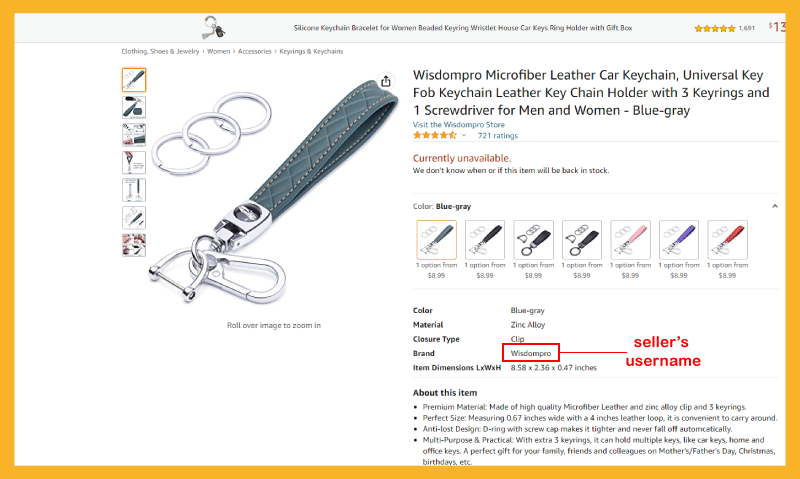
2 – Hit the Ask a Question button in the top right.
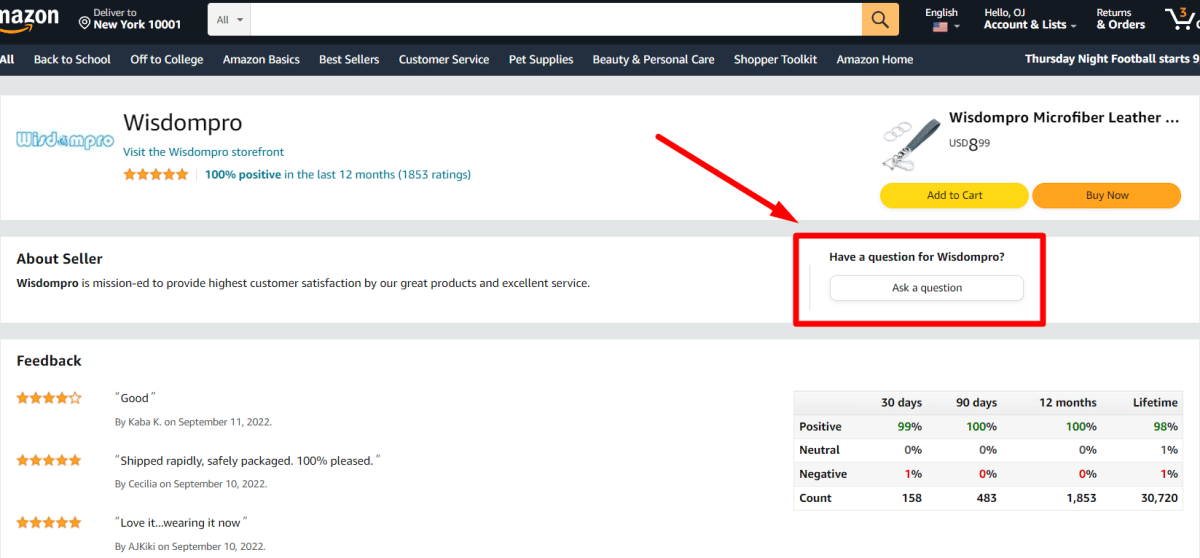
3 – Select An item for sale, then click Question about a product. Alternatively, you may be asked to say what you need help with.
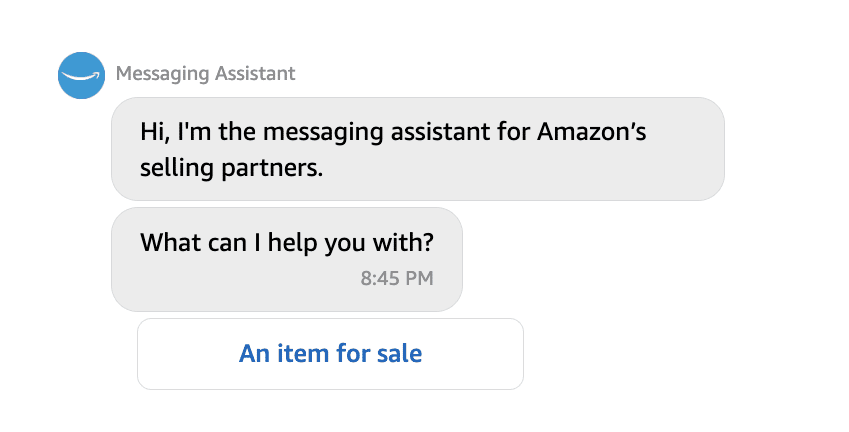
4 – Paste your cease and desist letter and submit it.
Sending Amazon a Hijacker Report
After giving hijackers the chance to explain themselves and they don’t take advantage of the opportunity, it’s time to take things up a notch.
One of the ways you can take down hijacked Amazon listings is through the platform’s Report Infringement Form. Learn all about this by reading our blog on Amazon Copyright Infringement.
Take note that it takes around 1-3 business days before Amazon responds to amazon sellers complaint.
In case Amazon takes a long time to respond, you can send another infringement form with more screenshots and specific details or information.
You may also take advantage of numerous online legal services to help beef up your report and make it legally effective.
Asking Others to Buy from and Complain against a Counterfeit Seller
If diplomacy and the traditional Amazon reporting route don’t work, there is a more hardball (yet legal) approach against sellers of fake products.
Pro tip: Since this measure requires paying for a fake product, only reserve this tactic for counterfeit sellers who have the Buy Box to maximize your return on investment.
Enlisting the help of your friends and Amazon, you can do the following:
- Request your friend (not a relative) to test buy the fake or hijacked product. Choose the quickest shipping option.
- After your friend receives the product, tell him or her to complain to the seller through the Report a Problem link. Have your friend select the option about the product not being materially the same.
- Wait 24 hours after doing step 2, then file an A to Z request against the fake product seller.
- Use the terms fake, not authentic, or counterfeit in your claim during step 3.
Ideally, Amazon will take down the hijacker’s listing within a few days.
Protecting Yourself from Hijackers
Giving hijackers a healthy dose of Benjamin Franklin’s ounce of prevention is a good way to protect yourself from them.
Among the many ways you can prevent hijackers from taking advantage of your product listings include:
- Make sure the photos and packaging of your product have your customized logo.
- Trademark your products.
- Enroll your online store in the Amazon Brand Registry program.
- Add special value to your product offering.
- Have a separate website to market your products.
- Avail of an automated hijack alert.
Let’s have a look at each preventive measure mentioned above.
Ensuring Your Product Has Your Unique Logo
Designing your own product’s logo protects you from brand hijacking, another term for a situation where other sellers misrepresent your brand to sell poor-quality products.
Aside from having a logo, make sure your product photos clearly display your logo, as you can see in the screenshot below.
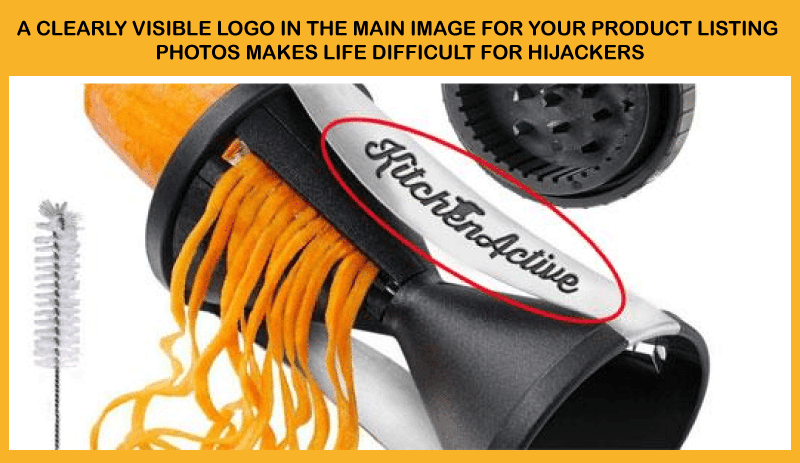
The main image should show your logo well, as well as comply with other sales-enhancing image guidelines to keep your business healthy.
Taking Advantage of Trademark-Related Legal Protection
You would be under greater legal protection if you registered your logo or brand as a trademark in the country where you’re selling.
For instance, if your Amazon marketplace account sells in the United States, you should head over to uspto.gov (the website of the U.S. Patent and Trademark Office) and do the following:
1 – Hover over the Trademarks tab.
2 – Click Apply online, which is under Application process.
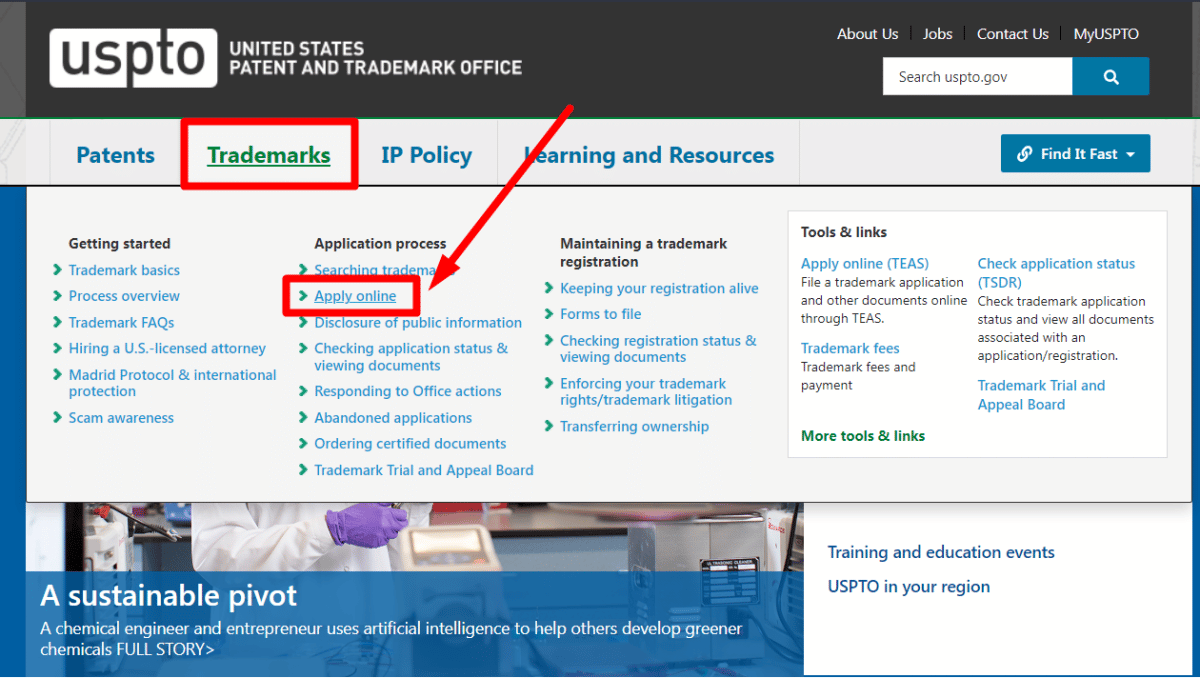
3 – Follow the steps written on the website.
4 – Wait for a patent examiner to inform you of the next steps.
Since registering your trademark costs money, I advise you to do this only after you have enough savings for the cost. However, in the long run, investing in trademark protection will go a long way in fending off counterfeit sellers and give you the right to legal compensation (money in exchange for harm done).
Pro tip: Even if someone copies your trademark and you haven’t had your logo registered at the Patent and Trademark Office, you still have the legal right to tell the counterfeit logo maker to stop (under the First Rights Use doctrine).
Getting into Amazon Brand Registry

Creating your logo and registering it as a trademark is necessary for this measure.
Whether you have a text- or image-based logo, as long as it is registered as a trademark at the patent office of the host country of your Amazon store, you can have your brand enrolled in the Brand Registry.
Once you have a registered brand, you’re under the protection of this Amazon program, and it will be easier to detect, report, and remove listing hijackers and other similar unethical sellers.
Despite the protective power of the Brand Registry, it is only available in certain host countries.
Here’s a full guide to help you register your brand on Amazon’s brand registry.
Making Your Products Extra Special
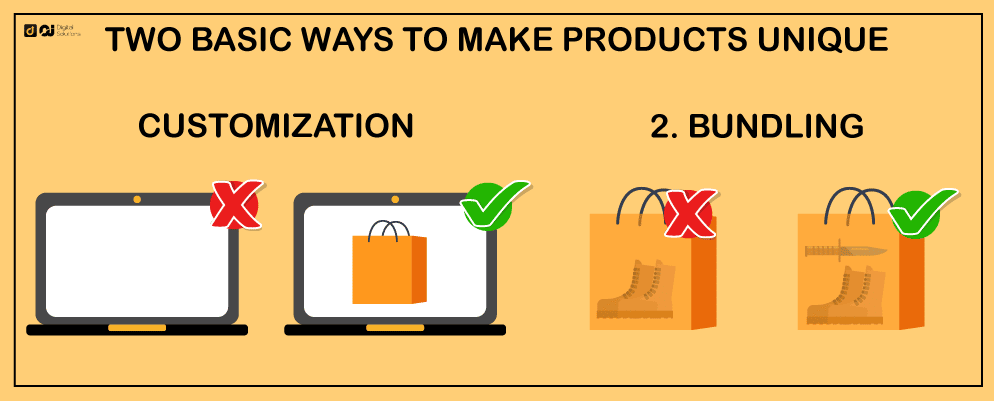
Hijackers find it hard to duplicate unique products.
You can add special value to your product offerings either through customization or bundling.
An example of customization could be selling a laptop with a case where buyers can choose the color or design they want.
Bundling, on the other hand, is simply adding another related product to your listing. For example, if you’re selling a shoe for hiking, why not add a Swiss Army knife to the listing (both the shoes and knife are useful on camping trips)?
It is difficult for counterfeiters to imitate a listing where two or more products are bundled together.
Promoting Your Product through a Different Website
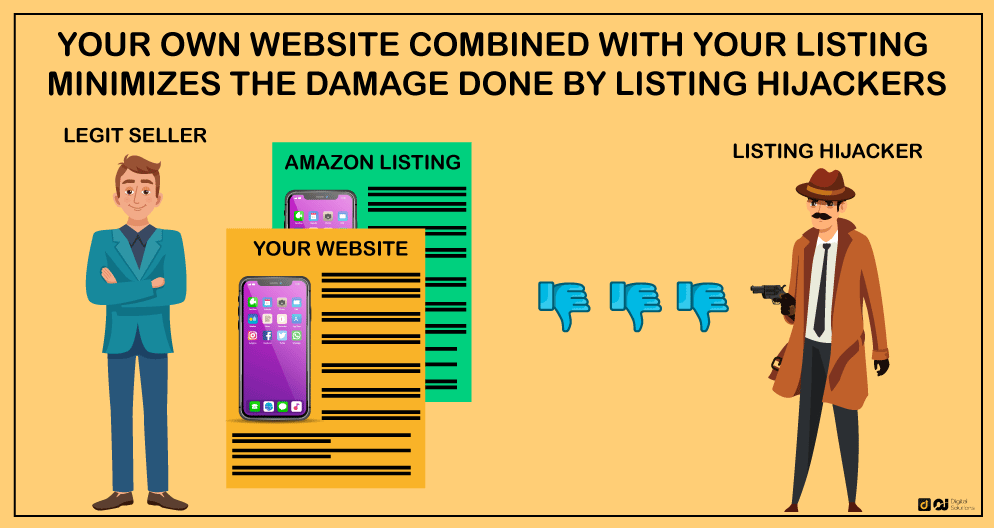
Having a product-promoting website other than Amazon is a good way to fend off hijackers.
The website doesn’t have to have costly add-ons like the capability to receive payments for your products. Instead, this website (which you could set up and operate for free using content management systems like WordPress) is additional solid evidence to help Amazon take down hijacked listings.
To better understand the need for an alternate website, imagine the said site as the e-commerce equivalent of a promotional booth where a person uses flyers to direct potential buyers to your brick-and-mortar store.
As the booth has flyers, your website has links to direct Internet users to your Amazon product listings.
In a nutshell, your website for promoting products serves as additional evidence for better hijacker takedowns and a way to direct potential buyers to your Amazon product listing.
Subscribing to an Automated Hijacking Alert
There are companies out there who, for a fee, let you focus on selling instead of wasting your time vigilantly looking out for hijackers like a police officer.
These companies, depending on the package they offer, inform you of the following hijacking-related anomalies:
- Suddenly losing your Buy Box badge
- An unauthorized person making changes to your product listing title
- Irregularities involving negative or neutral product reviews
- A radical price drop in a listing similar to yours
Now that I’ve covered a lot of ground regarding Amazon listing hijacking, it’s time for some commonly-asked questions related to this problem.
Frequently Asked Questions
How long is the waiting time for a reply to cease and desist letters?
You must give hijackers around a day or two to respond to your cease and desist letter. However, this rule is not set in stone.
Do sellers who receive cease and desist letters fight back?
Yes, sometimes these sellers respond in a way that could cause you legal problems.
That is why it is vital to determine first whether a seller who you suspect is selling counterfeit products is a hijacker or merely a reseller. Some legitimate resellers who have the financial resources hire lawyers to turn the tables around and hit those who send cease and desist letters with a counter lawsuit.
How effective is Amazon Brand Registry in responding to infringement notices?
Some studies indicate that around 95% of infringement notices sent by sellers are investigated and acted upon within 24 hours.
Take Back Control of Your Reputation and Business
Now that you know what Amazon listing hijacking is, its effects, and how to defend against and fight it, it is time to turn things around.
Through the techniques I discussed in this article, you can take control of your Amazon store and regain the trust of your customers while earning more in sales.

